I have lived in this small rural parish for nearly 5 years now and have come to look forward to celebrating the harvest being safely gathered in. This year the weather was a challenge for farmers once again and with a fine field of sturdy wheat stretching from the back of our garden, over the hill and out of sight, we felt particularly anxious that the warm weather of early September should last long enough to enable the wheat to be harvested in its optimal state. As we drove around locally we could see the combine carving its way through the landscape, trailing billows of grain dust in its wake, while lorries, like handmaidens, scuttled back and forth taking the grain from the combine to storage. But it never seemed to come to our field. The furthest field – which is so big and bosomy that the first time we saw a tractor on it we feared its sudden disappearance meant it had dropped off the edge of the world – got the full treatment with the hum of activity continuing long after we had drawn the curtains and gone to bed. Surely ours would be next. When my husband met me off the bus from work, the first words on our lips concerned the whereabouts of the combine and what it was doing there. The call from the farmer (to suggest shutting our windows, not because he suspected we were nervous wrecks) came at teatime three Saturdays ago and for a while it was touch or go whether we’d opt for watching Inspector Montalbano on BBC4 or have our noses pressed to the window checking that the gloriously golden corn (which looked at its most beautiful in the slanting late evening sun) was being properly dealt with. I really wouldn’t have thought you could be emotionally attached to a field of wheat, but I now know you can. And it was the same last year. Before that we had had sheep in the field and had become equally attached to the lambs. I have to admit that as the lambs grew and gambolled a little less charmingly and made rather more noise, we came to feel less attached to them, but all in all this visceral reaction to what goes on in this random patch of land has surprised me.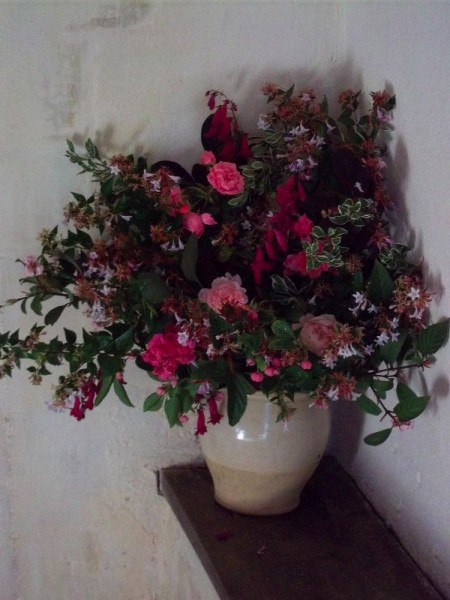
So, to understand what happens beyond my back garden and in the interest of tightening up sloppy, slack thinking, I asked for enlightenment from our farmer/church warden.
Crop rotation still lies at the heart of agriculture – wonderfully some things never totally change. Typically, rotation is 4 years: feed wheat for volume, milling wheat for quality, barley; then comes a break crop which is either oil seed rape (OSR) or poppies.
It is impossible to write or speak the words oil seed rape without being prepared for a reaction, which is usually negative. Few of us love the bright garish yellow of the OSR which with its sickly sweet scent prints its presence firmly on early summer. However, if you are a farmer its benefits are outstanding. OSR is the only one of the 4 main oils (soya, sunflower, palm and rape) which can be grown in the UK. (Olive oil is probably the very best but it is also the most expensive and the volume produced is comparatively small.) OSR is also the healthiest with regard to fatty acids, being rich in both Omega 3 and Omega 6 and low in saturated fats. It is the most nutritionally balanced cooking oil and even the near-beatified Hugh Fearnley-Whittingstall is said to have become enthusiastic about its use. When leaves first appear they have the look of some sort of beet and this makes sense as rapum is latin for a turnip. But then as it grows and matures it looks completely different and to my untutored eyes it comes to look more like a legume so I was surprised to discover that it is in fact a brassica. Well, that just shows I can’t tell cabbages from peas. It is harvested after the barley in early August and sometimes the crop seems to have turned black and unpleasant looking by this time. Our farmer sells it on as soon as it is dry enough in the barn as he has insufficient storage space.
Barley is normally the first crop to be harvested, typically in the second week of July. The preferred end use is for malting which attracts a higher price and a variety is chosen accordingly. However, the desired remuneration will not be realised if the nitrogen levels rise above an accepted level and this varies according to fertilizer applied and rainfall. If not of a quality for malting, the barley will go to animal feed, which seems to be the bottom of most of these sophisticated food chains.
Next typically comes the milling wheat. Our farmer grows a contract for Warburtons, which he tells me is the second biggest food and drink brand in the country after Coca Cola (which I never really think of as a food and drink brand, but never mind). This is where premiums are earned for tightly defined specifications – however beautiful it looks, it is qualities like hardness (of what?) and protein content that qualify the yield for a ‘substantial premium’. (I think this is where too much rain at the wrong time becomes important and I think here lies the source of the unease in the vicarage at harvest time. Only now that I think about it I think we may have feed wheat – of which more below – behind us and not milling wheat. It is impossible to tell the difference, I think you have to be in the know. ) If the crop is not good enough this wheat goes into the secondary food market for things like biscuits. The poorest grain goes – yes you guessed it – for animal feed. It must be agony watching bad weather knock pound signs off your crop.
At about the same time as the milling wheat is being harvested Johnson Mathhey arrive and forage harvest the poppies which have been grown for them. As with OSR, the poppies have first been desiccated. This is then stored on the farm, usually until about Christmas. First the poppy straw goes to a plant near Northampton where the seed is extracted and sent to the catering trade, mainly in the USA where poppy growing is illegal. The remaining straw is hot pelletised and sent to Edinburgh where JM have the only poppy process factory in the UK. UK supplies of straw provide about 20% of what is required, the rest comes from Tasmania and Spain. The powder is then made into codeine and morphine for the pharmaceutical industry. There’s some comfort in thinking should you ever need a painkiller that does the trick that 20% of it may be grown in your back yard. This year the poppies were grown opposite the church on poorish soil (I look at it and think Helmand) and were a wonderful sight in full bloom. The medicinal poppy, papaver somniferum is a beautiful flower – a mauvy white with a deeper mauve flush to the base of the petals. Last year a couple who were married in the church were photographed in a field near the family home in the midst of poppies in full bloom, heads the size of tea plates held aloft on silver-green stems rising nearly up to their waists (though so profuse were the blooms that little stem was visible) and the bride’s bouquet languishing completely unseen below the poppy line. It is a wonderful photograph not least because the young couple are so obviously amused and thrilled by their glorious setting. Whenever we have visitors we always show them the photograph and ask where they think it was taken. I wish I could show the photograph here, but even inconsequential publications such as this should not seek to exploit the privacy of parishioners in the urge for making my blog look better.
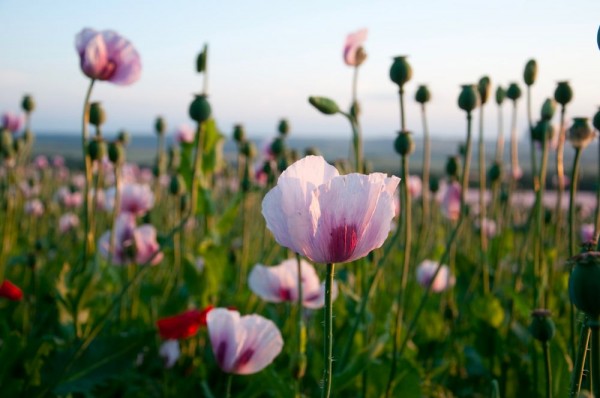
Papaver somniferum grown locally: photographed by Jon Scourse
see other beautiful photos at www.jonscourselandscapes.net
To return to our crops, the last to be harvested is feed wheat which the farmer hopes will yield heavily. “Absolutely not this year, the wettest in memory.” In good years and with luck on his side the farmer might find this is good enough to get him a small premium in the human food chain. Nuff said.
However, the idea that the harvest is safely gathered in and that is the end of it is naive. Once harvested it is absolutely imperative to keep the moisture below a certain moisture (and temperature) content. In the case of wheat and barley the aim is for 14.5% total moisture, any higher and the customers will reject or at best penalise. After rain, harvesting can’t occur for a couple of days and tension must be high in the farmhouse. Nowadays grain can be dried after harvest but it is a slow, very expensive process and the farmer will often not have much capacity to do it.
So one cycle comes to an end, but the fields do not lie idle untenanted for long. It is ideal to get OSR drilled before the end of August, so turnaround time after barley will be a couple of days. Last to go in, in October, is probably winter milling wheat. Our farmer no longer grows any spring wheat or barley and poppies do not get drilled until late March, so uncultivated stubble remains through the winter for overwintering songbirds. The land is also involved in 2 agri-environmental schemes. One is known as Higher Level Stewardship and under this scheme field margins are left uncultivated as songbird food sources, which has the unintended consequence of providing lots of efficient dandelion seeds that parachute over into the vicarage garden and onto the vicarage lawn in particular. I have done very well with my battle against the dandelions since we came here because I have developed my own technique. As soon as I see the distinctive dandelion leaf formation, I remove the visible leaves and, going into attack with a hand held apple corer, I isolate the tap root, position the apple corer around it, wiggle and jiggle a bit and hey presto, the root will usually come away in one go. The apple corer tends to get a bit distorted as it’s seems to be made of a softer metal than the job requires, but I haven’t completely broken one yet.
Until 3 years ago we had a locally bred line of sheep. The entire flock of over 3000 animals was bought by a breeder based in Bucks who wanted to cross the local Hartline with a breed from New Zealand called Rissington Highlander. All this seems to be going well. Now there are no sheep, grass no longer comes into the rotation.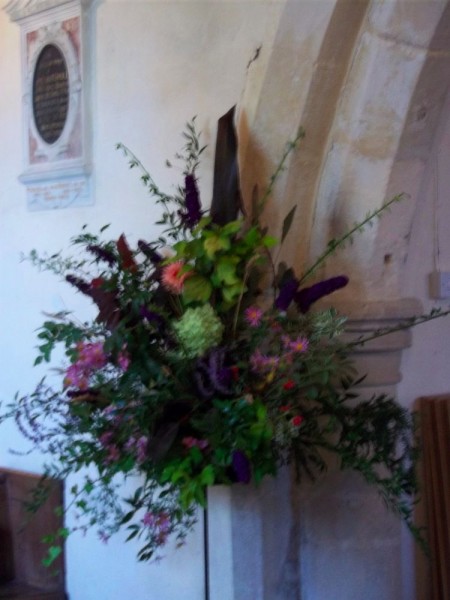
This is the context in which we come together in church to celebrate and give thanks. The flower arranging group had worked hard over two days to produce a lovely background of autumnal colour to bring the church alive. The village lady taxi driver/woodworker/award winning playwright (yes, all in the one being) had written a rhyming drama for 8 local children who were all dressed up as the various important figures in the chain of grain growing, from farmer, through miller to combine operator, etc. and had rehearsed them as much as all their combined commitments permitted. Our newly burdened Director of Music had found us a beautiful C18th anthem written by Maurice Greene and after a couple of rehearsals and lots of practicing with You Tube we were ready to make our contribution. A home made loaf made from locally grown wheat and in the shape of a wheatsheaf, was processed (as in a procession rather than as in manufacture) down the aisle to the altar as a physical reminder of the earth’s bounty. Throw in a couple of good readings , prayers reminding us of our blessings and of the world’s ongoing problems and 3 strong hymns for everyone to join in with and a memorable meaningful evening resulted. There are no more than 250 pople in the village which is really a number of little hamlets, yet 55 adults came to the service and there were 18 children. Afterwards, more than 30 came for a harvest supper at the vicarage and fed well on lasagne (not a very British dish but a good one to be kept ticking over in a low oven), pavlova, raspberry and redcurrent crumble and an apple and frangipane pithivier. An excellent evening.
Post Script 28.9.12:I’ve just been updated on the quality of the crop on field behind us, which was one of two fields growing a variety of wheat called Crusoe for seed. “Most of it has left the barn and it’s touch and go whether it will qualify for seed; the germination may be just short of requirement; if so another premium forgone.” Oh dear, it’s rather like A-Level results not being quite what you hoped for, especially when things were looking rather promising in the push to the line.

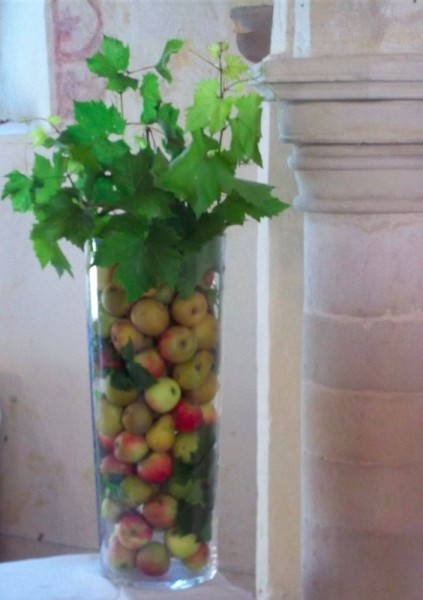
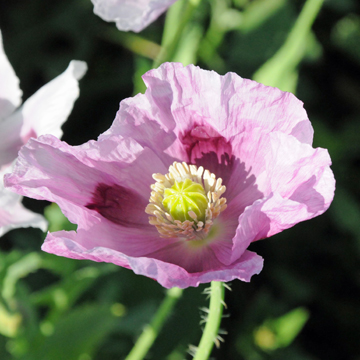
4 Comments
Beautifully comprehended and written……………
Thank you, I was given a rather a good brief to work from. Hope you enjoy the embroidery as much!
We have so much enjoyed this masterly and splendidly written description……
Well, I can only pass on thanks to my farming advisor for providing exactly the sort of information I wanted. I realised how shockingly little I knew about what happened around me.
2 Trackbacks
[…] here (at the end of my post ‘Harvest’ for 2012) for more about opium poppies as a […]
[…] more about opium poppies see here & here (half-way through my post on harvest if you want to know about it as cash […]